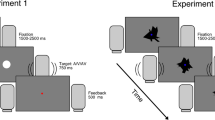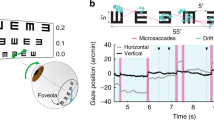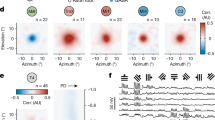Abstract
In non-commutative algebra, order makes a difference to multiplication, so that a × b ≠ b × a (refs 1, 2). This feature is necessary for computing rotary motion, because order makes a difference to the combined effect of two rotations3,4,5,6. It has therefore been proposed that there are non-commutative operators in the brain circuits that deal with rotations, including motor circuits that steer the eyes, head and limbs4,5,7,8,9,10,11,12,13,14,15, and sensory circuits that handle spatial information12,15. This idea is controversial12,13,16,17,18,19,20,21: studies of eye and head control have revealed behaviours that are consistent with non-commutativity in the brain7,8,9,12,13,14,15, but none that clearly rules out all commutative models17,18,19,20. Here we demonstrate non-commutative computation in the vestibulo-ocular reflex. We show that subjects rotated in darkness can hold their gaze points stable in space, correctly computing different final eye-position commands when put through the same two rotations in different orders, in a way that is unattainable by any commutative system.
This is a preview of subscription content, access via your institution
Access options
Subscribe to this journal
Receive 51 print issues and online access
$199.00 per year
only $3.90 per issue
Buy this article
- Purchase on Springer Link
- Instant access to full article PDF
Prices may be subject to local taxes which are calculated during checkout



Similar content being viewed by others
References
Hamilton, W. R. Lectures on Quaternions (Hodges, Dublin, (1853).
Schutz, B. Geometrical Methods of Mathematical Physics (Cambridge Univ. Press, Cambridge, (1980).
McCarthy, J. M. An Introduction to Theoretical Kinematics (North-Holland, Amsterdam, (1990).
Westheimer, G. Kinematics of the eye. J. Opt. Soc. Am. 47, 967–974 (1957).
Tweed, D. & Vilis, T. Implications of rotational kinematics for the oculomotor system in three dimensions. J. Neurophysiol. 58, 832–849 (1987).
Carpenter, R. H. S. The Movements of the Eyes (Pion, London, (1988).
Tweed, D. & Vilis, T. Geometric relations of eye position and velocity vectors during saccades. Vision Res. 30, 111–127 (1990).
Crawford, J. D. & Vilis, T. Axes of eye rotation and Listing's law during rotation of the head. J.Neurophysiol. 65, 407–423 (1991).
Minken, A. W. H., van Opstal, A. J. & Van Gisbergen, J. A. M. Three-dimensional analysis of strongly curved saccades elicited by double-step stimuli. Exp. Brain Res. 93, 521–533 (1993).
Hestenes, D. Invariant body kinematics I. Saccadic and compensatory eye movements. Neural Netw. 7, 65–77 (1994).
Hestenes, D. Invariant body kinematics: II. Reaching and neurogeometry. Neural. Netw. 7, 79–88 (1994).
Tweed, D., Misslisch, H. & Fetter, M. Testing models of the oculomotor velocity-to-position transformation. J. Neurophysiol. 72, 1425–1429 (1994).
Smith, M. A. & Crawford, J. D. Neural control of rotational kinematics within realistic vestibuloocular coordinate systems. J. Neurophysiol. 80, 2295–2315 (1998).
Tweed, D. Athree-dimensional model of the human eye-head saccadic system. J. Neurophysiol. 77, 654–666 (1997).
Henriques, D. Y. P., Klier, E. M., Smith, M. A., Lowy, D. & Crawford, J. D. Gaze centered remapping of remembered visual space in an open-loop pointing task. J. Neurosci. 18, 1583–1594 (1998).
Van Opstal, A. J., Hepp, K., Hess, B. J. M., Straumann, D. & Henn, V. Two- rather than three-dimensional representation of saccades in monkey superior colliculus. Science 252, 1313–1315 (1991).
Schnabolk, C. & Raphan, T. Modeling three-dimensional velocity-to-position transformation in oculomotor control. J. Neurophysiol. 71, 623–638 (1994).
Straumann, D., Zee, D. S., Solomon, D., Lasker, A. G. & Roberts, D. Transient torsion during and after saccades. Vision Res. 35, 3321–3334 (1995).
Raphan, T. In Three-dimensional Kinematics of Eye, Head and Limb Movements (eds Fetter, M., Haslwanter, T., Misslisch, H. & Tweed, D.) 359–376 (Harwood, Amsterdam, (1997).
Raphan, T. Modeling control of eye orientation in three dimensions. I. Role of muscle pulleys in determining saccadic trajectory. J. Neurophysiol. 79, 2653–2667 (1998).
Quaia, C. & Optican, L. M. Commutative saccadic generator is sufficient to control a 3-d ocular plant with pulleys. J. Neurophysiol. 79, 3197–3215 (1998).
Miller, J. M., Demer, J. L. & Rosenbaum, A. L. Effect of transposition surgery on rectus muscle paths by magnetic resonance imaging. Ophthalmology 100, 475–487 (1993).
Demer, J. L., Miller, J. M. & Poukens, V. Surgical implications of the rectus extraocular muscle pulleys. J. Pediatr. Ophthalmol. Strabismus 33, 208–218 (1996).
Robinson, D. A. Oculomotor unit behavior in the monkey. J. Neurophysiol. 35, 393–404 (1970).
Glasauer, S. Interaction of semicircular canals and otoliths in the processing structure of the subjective zenith. Ann. NY Acad. Sci. 656, 847–849 (1992).
Merfeld, D. M. Modeling the vestibulo-ocular reflex of the squirrel monkey during eccentric rotation and roll tilt. Exp. Brain Res. 106, 123–134 (1995).
Robinson, D. A. Amethod of measuring eye movement using a scleral search coil in a magnetic field. IEEE Trans. Biomed. Eng. 10, 137–145 (1963).
Koch, C. Biophysics of Computation: Information Processing in Single Neurons 471–473 (Oxford Univ. Press, New York, (1999).
Schultheis, L. W. & Robinson, D. A. Directional plasticity of the vestibuloocular reflex in the cat. Ann. NY Acad. Sci. 374, 504–512 (1981).
Peng, G. C., Baker, J. F. & Peterson, B. W. Dynamics of directional plasticity in the human vertical vestibulo-ocular reflex. J. Vestib. Res. 4, 453–460 (1994).
Acknowledgements
We thank D. M. Broussard, J. D. Crawford, J. Dichgans, C. E. Hawkins, J. A. Sharpe and T. Vilis for comments on the manuscript. This work was supported by the MRC of Canada and the Deutsche Forschungsgemeinschaft.
Author information
Authors and Affiliations
Rights and permissions
About this article
Cite this article
Tweed, D., Haslwanter, T., Happe, V. et al. Non-commutativity in the brain. Nature 399, 261–263 (1999). https://doi.org/10.1038/20441
Received:
Accepted:
Issue Date:
DOI: https://doi.org/10.1038/20441
This article is cited by
-
The brainstem control of saccadic eye movements
Nature Reviews Neuroscience (2002)
Comments
By submitting a comment you agree to abide by our Terms and Community Guidelines. If you find something abusive or that does not comply with our terms or guidelines please flag it as inappropriate.



